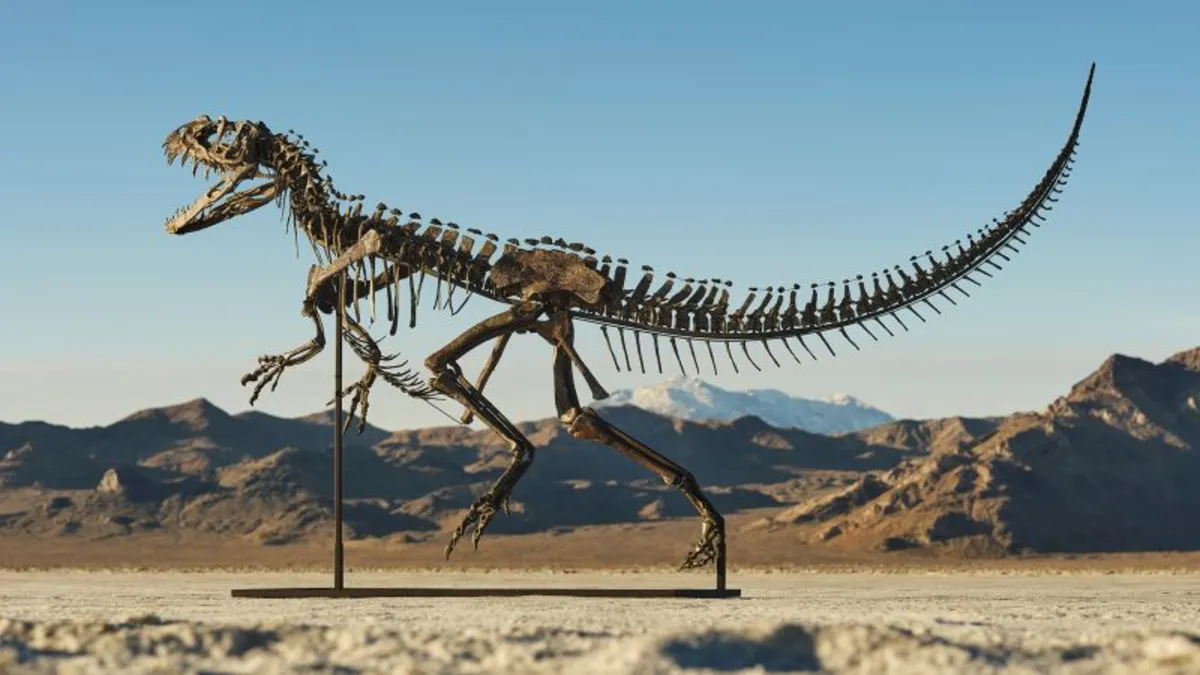
A stunning Ceratosaurus fossil, one of only four known specimens in existence, has recently been sold for an astounding $30.5 million at an auction held by Sotheby’s. This fossil is hailed as “one of the finest and most complete examples of its kind ever found,” according to a statement from the auction house released on Wednesday. The auction, which took place in New York, ignited a fierce six-minute bidding war among six bidders, ultimately leading to the jaw-dropping sale price that far exceeded its initial estimate of $4 million to $6 million.
The specimen in question is a juvenile Ceratosaurus nasicornis, a carnivorous dinosaur characterized by its distinctive nasal horn, elongated teeth, and bony armor adorning its back and tail. Measuring a height of six feet, three inches (1.9 meters) and a length of approximately 10 feet, eight inches (3.25 meters), this juvenile fossil comprises 139 bone elements, including 57 that form a “superb virtually complete skull,” as noted by Sotheby’s.
Discovered in 1996 at the Bone Cabin Quarry in Wyoming, this remarkable fossil dates back to the late Jurassic period, around 150 million years ago. It has been on display at the Museum of Ancient Life in Thanksgiving Point, Utah, from 2000 until 2024 and has not been formally studied or documented in a scientific journal, according to Sotheby’s.
Sotheby’s revealed that the buyer of this exquisite Ceratosaurus fossil intends to loan it to an institution, a fitting decision for a specimen of such rarity and significance. This intention raises hopes for its accessibility to the public and for potential educational opportunities.
In the same auction, a meteorite—recognized as the largest known piece of Mars on Earth—was sold for $5.3 million. Cassandra Hatton, the global head of science and natural history at Sotheby’s, commented on the auction results, emphasizing the deep-rooted fascination with the natural world, from cosmic phenomena to ancient Earth. “What draws collectors is more than just a passion for science; it’s a deep-seated curiosity about the forces that have shaped our planet and beyond,” she stated.
Mark Westgarth, a professor at the University of Leeds, noted that this sale exemplifies a recent resurgence of interest in fossils and natural history. This growing trend is reflected in Sotheby’s previous auction of the most valuable fossil ever sold, Apex the Stegosaur, which reached a staggering $44.6 million in July 2024. Westgarth noted, “At the top end of the market … there seems to be an increasing desire for ‘distinction.’” He also remarked on the aesthetic qualities of dinosaur specimens, describing them as sculptural and awe-inspiring.
However, not everyone shares the enthusiasm for such high-stakes auctions. Steve Brusatte, a paleontology professor at Scotland’s University of Edinburgh, expressed concerns regarding the accessibility of dinosaur fossils. He questioned who possesses the financial means to invest tens of millions of dollars in a dinosaur, suggesting that museums or educational institutions may not be able to afford such purchases. “My fear is that this skeleton will disappear into the ether, into the mansion of an oligarch or a bank vault to accumulate value as just another investment,” Brusatte warned.
Despite these concerns, Westgarth contends that there is a “symbiotic” relationship between the fossil market and broader research interests. He referenced Mary Anning, a pioneering fossil collector from the early 19th century, whose work spurred increased public interest and research activity in the field of paleontology. Westgarth expressed optimism that the buyer's intention to loan the Ceratosaurus fossil to a research institution could foster future research endeavors.